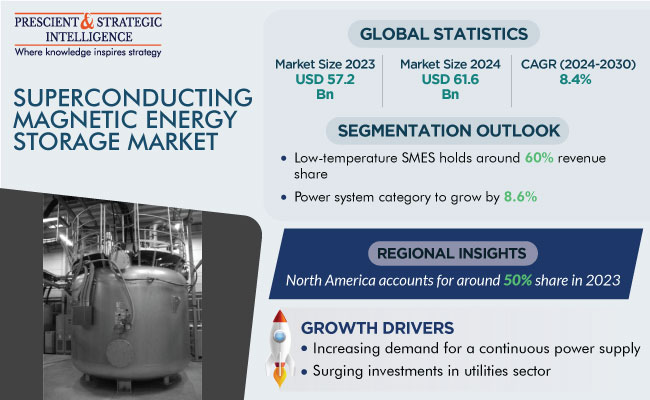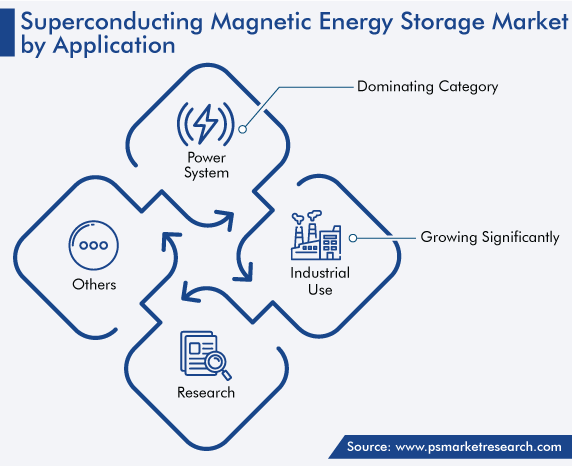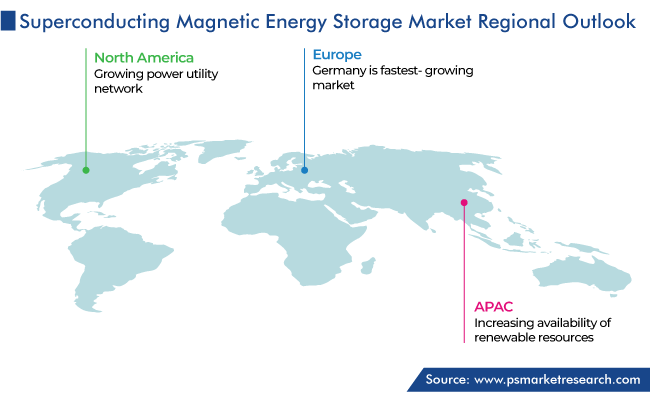Report Code: 12789 | Available Format: PDF | Pages: 250
Superconducting Magnetic Energy Storage Market Size and Share Analysis by Type (Low-Temperature SMES, High-Temperature SMES), Application (Power System, Industrial Use, Research) - Global Industry Demand Forecast to 2030
- Report Code: 12789
- Available Format: PDF
- Pages: 250
- Report Description
- Table of Contents
- Market Segmentation
- Request Free Sample
Market Overview
The superconducting magnetic energy storage (SMES) market is set to generate an estimated revenue of USD 57.2 billion in 2023 and witness a CAGR of 8.4% during 2024–2030, ultimately reaching USD 100.1billion by 2030. The key drivers for the market are the increasing demand for a continuous power supply, rising efforts for grid modernization, and surging investments in the utilities sector.

In such a system, magnetic energy is generated by passing an electrical current through a superconducting coil. Whenever there is a requirement for stored energy, the magnetic energy is converted back to electricity and discharged to the transmission network. One of the benefits of using the system is the conduction of electricity without any loss, which gives it a high efficiency and makes it reliable and popular.
The significance of energy storage lies in the fact that it increases energy security by providing backup power during natural disasters and grid failures. This feature becomes essential for regions that are susceptible to severe weather events. Hence, many research and development projects are going for energy storage technologies, including superconducting energy storage; as well as for the enhancements of the chemistry of batteries and other aspects, for cost reduction and improved performance.
Rise in Energy Consumption Is Expected To Drive Market Expansion
The demand for a continuous power supply is increasing across the globe due to urbanization and the increasing population. Moreover, for over a century, electricity has been a basic need of industries, economies, and the overall human society. To satisfy the growing demand, the role of energy storage becomes apparent. Other factors that would lead to the growth of the market are the enhanced performance of these systems as compared to the primitive technologies, such as high efficiency, rapid response, longer life cycle, high power density, and low maintenance.
The electrification of the transportation sector is another major factor that helps drive the market forward. Governments are providing subsidies to reduce the harmful effects of fossil-fuel-powered vehicles on the environment, which is propelling the shift toward electric vehicles. Moreover, people are themselves slowly understanding the need to keep the environment green and clean.
According to the International Energy Agency, electric car sales exceeded 10 million units in 2022. With more automobiles running on electricity, the load on the grid will increase, in turn, creating a high demand for efficient energy storage technologies.
Moreover, many countries are making efforts to enhance the percentage of renewable energy sources in their energy mix, so that moving away from fossil fuels becomes easier. Renewable sources, especially solar and wind, have a sporadic output, as their operation depends on the weather; thus, storage systems are essential for ensuring a robust energy supply and reliability.
Further, the rapid grid modernization is accelerating the growth of the global superconducting magnetic energy storage market. Furthermore, the pollution generated by the recycling of lead–acid batteries, which are widely used in ESS currently, will bring bright growth opportunities for industry players. Since SMES systems can provide frequency variations, help mitigate voltage fluctuations, respond rapidly to electricity demand, and tackle other grid turbulences, they enhance the stability of the grid and lower the rate of power interruptions.
These, apart from enhancing and simplifying distribution and transmission, are the usual stages in grid modernization. Power can be transmitted more efficiently by placing SMES systems strategically in substations and other critical points in order to lower transmission line losses and stabilize the voltage.
To boost the stability of transmission loops, such units are used by utilities as they can help in enhancing power quality, reducing losses, and boosting the overall efficiency. Here, the rising investments in the utilities sector and the government policies inspiring the adoption of SMES systems will propel the market during this decade.
| Report Attribute | Details |
Market Size in 2023 |
USD 57.2 Billion |
Market Size in 2024 |
USD 61.6 Billion |
Revenue Forecast in 2030 |
USD 100.1Billion |
Growth Rate |
8.4% CAGR |
Historical Years |
2017-2023 |
Forecast Years |
2024-2030 |
Report Scope |
Market Trends, Drivers, and Restraints; Revenue Estimation and Forecast; Segmentation Analysis; Impact of COVID-19; Companies’ Strategic Developments; Market Share Analysis of Key Players; Company Profiling |
Segments Covered |
By Type; By Application; By Region |
Explore more about this report - Request free sample
Rising Adoption of Low-Temperature SMES Systems
The low-temperature SMES bifurcation is projected to grow at a rate of 8.5% from 2024 to 2030 because of the higher operational safety of this technology than its high-temperature counterpart. Other than that, low-temperature SMES has a higher energy density, due to which it can store an ample amount of power. Additionally, these have high efficiency, enabling the storage and recovery of electricity with negligible energy loss. This feature becomes important for applications where energy conservation is a necessity. Moreover, it has a longer lifecycle, which helps in reducing the replacement and maintenance costs over time.
It also excels in particular niche applications where there is a requirement for less response times, reliability, and high efficiency. These applications include many in the healthcare and aerospace sectors and research institutions, as well as grid stabilization projects, all of which need rapid and precise energy inputs. Further, with extensive R&D being carried out to make this technology even better, the low-temperature SMES category will continue to grow over the forecast period.
Power System Category Dominates Market
The power system category dominates the market, and it will grow at a rate of 8.6% during 2024–2030. This is primarily attributed to the expansion of the grid system to meet the continuously increasing demand for electricity. SMES systems are incorporated into important facilities, such as medical centers and data centers, for providing power anytime, especially during grid emergencies or outages.
Essentially, for power systems, SMES addresses numerous challenges, such as those in peak demand management, intermittency of renewable energy sources, and grid instability. As the demand for sustainable, efficient, reliable energy solutions continues to rise, the power system category will keep growing in the application segment.
Further, the government policies and incentives to promote the implementation of energy storage technologies to improve grid stability, boost renewable energy utilization, and fulfill sustainability goals drive this category. Furthermore, with technological advancements, the usage of this technology in small- and large-scale power systems will rise in the coming years.

North America Is Largest Regional Market
Geographically, North America is the largest SMES market, with a share of 50% in 2023, due to the growing power utility network. According to the U.S Energy Information Administration, renewable energy production and consumption reached 13% of the total energy production as well as consumption in 2022. The increment in recent years is credited to high wind, solar, and hydroelectricity production.
Further, in the U.S., R&D is being undertaken to advance SMES systems, to cope with the rising power demands, stabilize the grid, and integrate renewable energy sources. Further, various states in the U.S. have set targets for energy storage and launched incentives for augmenting the adoption of SMES. Canada is also showing an interest in this technology for grid applications, and it continues to make investments in this regard.

APAC Is Fastest-Growing Market
APAC is expected to grow at the highest CAGR, of 8.9%, from 2024 to 2030. This is attributed to the increasing availability of renewable resources, surging focus on smart grids and distributed ESSs, rising energy demand, flourishing electronics industry, booming population, and strong manufacturing capabilities of India, China, South Korea, and Japan.
The most-significant country in the SMES market of this region is China, which is undertaking numerous research initiatives and pilot programs to improve the efficiency and usefulness of these systems. Moreover, the number of cities is rising across the whole APAC region, which would expand the growth prospects for the market, as cities consume more electricity than rural areas.
Additionally, the growing awareness of the benefits of SMES systems and the increasing demand for energy will help this market grow. Moreover, it has become essential for industry players, governments, and research institutions to continue investing in and supporting the SMES technology for a sustainable energy future in the region.
Top Providers of Superconducting Magnetic Energy Storage Solutions Are:
- American Superconductor Corporation
- Fujikura Ltd.
- Nexans S.A.
- Luvata
- ASG Superconductors spa
- Bruker Corporation
- Sumitomo Electric Industries Ltd.
Market Size Breakdown by Segment
This fully customizable report gives a detailed analysis of the superconducting magnetic energy storage market industry from 2017 to 2030, based on all the relevant segments and geographies.
Based on Type
- Low-Temperature SMES
- High-Temperature SMES
Based on Application
- Power System
- Industrial Use
- Research
Geographical Analysis
- North America
- U.S
- Canada
- Europe
- Germany
- U.K.
- France
- Italy
- Spain
- Asia-Pacific
- Japan
- China
- India
- South Korea
- Australia
- Latin America
- Brazil
- Mexico
- Middle East and Africa
- Saudi Arabia
- South Africa
- U.A.E.
The 2023 estimated size of the market for superconducting magnetic energy storage solutions is USD 57.2 billion.
The superconducting magnetic energy storage industry will value USD 100.1 billion by 2030.
The low-temperature bifurcation dominates the type segment of the market for superconducting magnetic energy storage solutions.
Power system applications hold the largest share in the superconducting magnetic energy storage industry.
The market for superconducting magnetic energy storage solutions is propelled by the rising electricity demand and rampant renewable energy capacity augmentation.
North America generates the highest revenue in the superconducting magnetic energy storage industry.
APAC will witness the highest CAGR in the market for superconducting magnetic energy storage solutions.
Want a report tailored exactly to your business strategy?
Request CustomizationWant an insight-rich discussion with the report author?
Speak to AnalystOur dedication to providing the most-accurate market information has earned us verification by Dun & Bradstreet (D&B). We strive for quality checking of the highest level to enable data-driven decision making for you
Our insights into the minutest levels of the markets, including the latest trends and competitive landscape, give you all the answers you need to take your business to new heights
With 24/7 research support, we ensure that the wheels of your business never stop turning. Don’t let time stand in your way. Get all your queries answered with a simple phone call or email, as and when required
We take a cautious approach to protecting your personal and confidential information. Trust is the strongest bond that connects us and our clients, and trust we build by complying with all international and domestic data protection and privacy laws